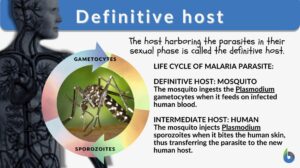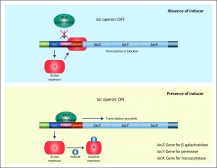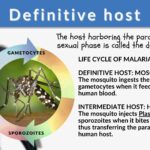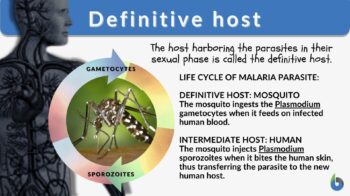
Definitive host
n., plural: definitive hosts
[dɪˈfɪn.ɪt.ɪv hoʊst]
Definition: the host where the sexual phase of the parasite’s life cycle occurs
Table of Contents
Different Biological Relationships
The biological world is interconnected whether we notice it or not. All the life forms depend upon each other to run this biosphere in a well-balanced way. Different types of biological relationships exist in our biosphere, like mutualism, commensalism, amensalism, parasitism, competition, predation, co-occurrence (neutralism), etc. Have a look at the table below to gain basic insights into how two different species interact in these relationships respectively.

All these different types of ecological and symbiotic relationships help organisms survive in their respective niches. Niche is a physical dimension space that a biological life form occupies. To aid the species continuation, biological organisms produce more of their kind via reproduction. Throughout their lives, these organisms have various requirements like food, shelter, protection, reserve fund for the future, etc. So, the question that arises is “who takes care of these requirements?”
In mutualistic, commensalistic, and parasitic relationships, the hosts play some very vital roles that help in the sustenance of species. A host is “a harboring organism that provides all the hospitality services to a guest organism”. The host fulfills all the basic requirements of food, shelter, protection, reserve fund for future, etc of the guest organism/s.
The hosts are basically of five types. Before moving on to our topic of “definitive host” and answering the big question “what is a definitive host”, let’s have a look at the illustration below and understand the different host types.
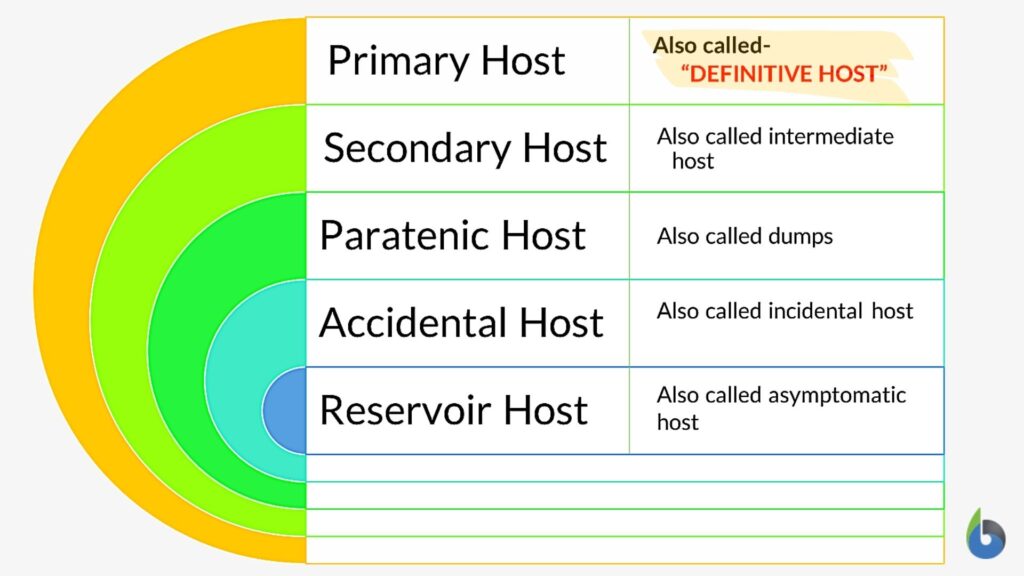
Parasite-Host Relationships
While a host is indispensable in all these relationships like mutualistic, commensalistic, and parasitic, we talk of two hosts- primary (definitive hosts) and secondary (intermediate hosts) in light of “parasitic relationships” only. A parasite-host relationship is a unique one as its “co-evolving”. By co-evolution, we mean that for every new adaptation that the host acquires to escape the parasite’s presence, the parasite also develops a “reciprocal or antagonistic” adaptation and co-evolves down the evolutionary timelines. This type of coevolution helps the parasite to develop a “consumer-resource interaction” with the host.
A parasite-host interaction is characterized by:
- Parasites in essence do not kill the host in a go (as opposed to predation where predators could eventually kill the prey); they extract and suck the nutrition out of the host as they live on/in them. This obviously harms the host.
- The hosts are typically bigger in size than parasites.
- The host’s fitness is reduced by the parasite.
- Parasites tend to increase their own fitness. They do so by feeding and extracting maximum nutrition out of the host’s body. Another way by which parasites increase their fitness is by taking assistance from a secondary host. Many parasites involve a secondary host in their life cycles to hop from one primary/definitive host to another.
- Some parasites involve 2 types of hosts in their life cycles, namely:
- Primary (Definitive hosts)
- Secondary (Intermediate hosts)
- Accordingly, the life cycles of parasites are of 2 types, namely:
- Direct life cycles: Only one definitive host is involved in these life cycles of parasites.
- Indirect life cycles: Two types of hosts are involved (definitive and intermediate) in these life cycles of parasites.
- Since parasites continuously have close interactions with other species, they tend to become “vectors” of many disease-causing pathogens and bring serious health implications to a variety of living organisms.
To learn more about the differences between these 2 hosts and the medical definition of the definitive host and intermediate host, look at the table below.
Table 1: Differences Between Definitive Host and Intermediate Host | |
|---|---|
| Definitive Host | Intermediate Host |
| It is that host that harbors the sexually-active phases of the parasite. | It is that host that harbors the non-sexual (reproductively/sexually immature) phases of the parasite. |
| Also called the “primary” host. | Also called the “secondary” host. |
| Site of sexual reproduction for the parasite. (So, if asked, a definitive host harbors which stage of a parasite… it’s the sexually-mature adult stage!) | Site of asexual reproduction for the parasite |
| Parasite spends a longer duration of its life cycle in this host. | Parasite spends a shorter/transient duration of its life cycle in this host. |
| Parasites’ gamete fusion and zygote formation happen in this host. | Parasites’ sexual differentiation happens in this host. |
| Examples: a) Plasmodium is a malarial parasite causing malaria. Definitive Host of Plasmodium= Female Anopheles mosquito | Intermediate Host of Plasmodium = Humans |
| b) Dirofilaria immitis is a heartworm parasite causing dirofilariasis. Definitive Host= Dog | Intermediate Host= Mosquito |
| c) Wuchereria bancrofti, Brugia timori, and Brugia malayi are nematode parasites causing lymphatic filariasis. Definitive Host= Humans | Intermediate Host= Mosquito |
Definitive Host Definition
A definitive host is a biological organism in whose body a parasite sexually multiplies and completes its life cycle. Reaching this sexual maturity is very important for the continuation of the parasite’s species. For example, human tapeworm makes use of humans as its definitive host. Synonym: primary host; final host. Compare: intermediate host
Now that we know how to define a definitive host, let’s look at some common examples and the diseases associated with the parasite harboring in the host’s body.
Definitive Host Examples
Some examples of definitive hosts are:
Table 2: Different parasites, their diseases, and definitive hosts | ||
|---|---|---|
| Parasite | Disease caused | Definitive Host |
| Plasmodium (P. falciparum, P. vivax, P. ovale and P. malariae.) | Malaria in humans | Female Anopheles mosquito |
| Dog heartworm (Dirofilaria immitis) | Pulmonary Dirofilariasis in humans | Domestic dogs, jackals, wolves |
| Dirofilaria tenuis, Dirofilaria repens | Subcutaneous dirofilariasis in humans | Only natural host for D. tenuis: raccoons Hosts of D. repens: Wild and domestic canids |
| Wuchereria bancrofti, Brugia timori, Brugia malayi | Lymphatic filariasis in humans | Humans |
| Chinese or oriental liver fluke (Clonorchis sinensis) and Opisthorchis viverrini, Opisthorchis felineus | Clonorchiasis in humans | Humans, dogs, cats, other piscivorous mammals |
| Tapeworm (Taenia solium, Taenia saginata, Taenia asiatica) | Taeniasis in humans | Humans |
| Blood trematodes (Schistosoma mansoni, Schistosoma haematobium, Schistosoma japonicum) | Schistosomiasis in humans | S. mansoni: Only humans S. japonicum: Cattle, horse, cats, dogs |
| Toxoplasma gondii | Toxoplasmosis in humans, cats, cattle, animals bred for human diet/consumption (livestock) | Domestic cats and their relatives |
| Trypanosoma cruzi, Trypanosoma gambiense, Trypanosoma rhodesiense | Trypanosomiasis/Sleeping Sickness T. cruzi– American Trypanosomiasis T. gambiense– West African sleeping sickness (chronic) T. rhodesiense– East African sleeping sickness (acute) | Mammals (humans) |
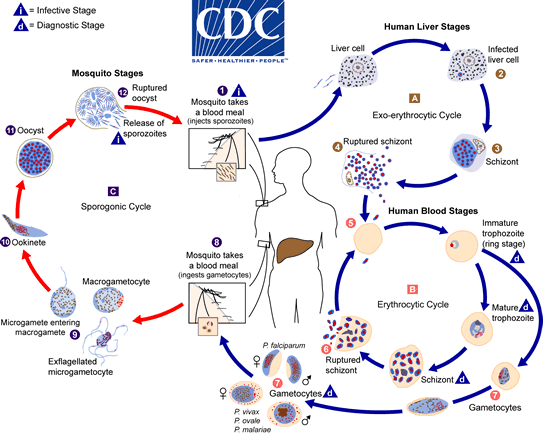
While on the other side, according to WHO, the parasite killed nearly 409,000 of its intermediate hosts- “the humans” in 2019. Image Credit: CDC.gov
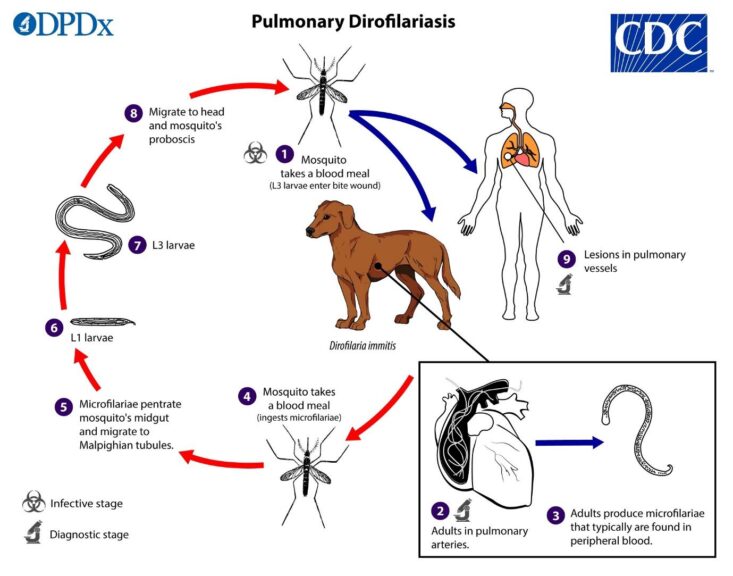
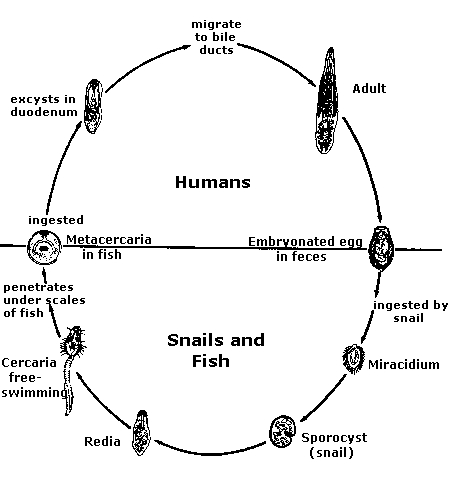
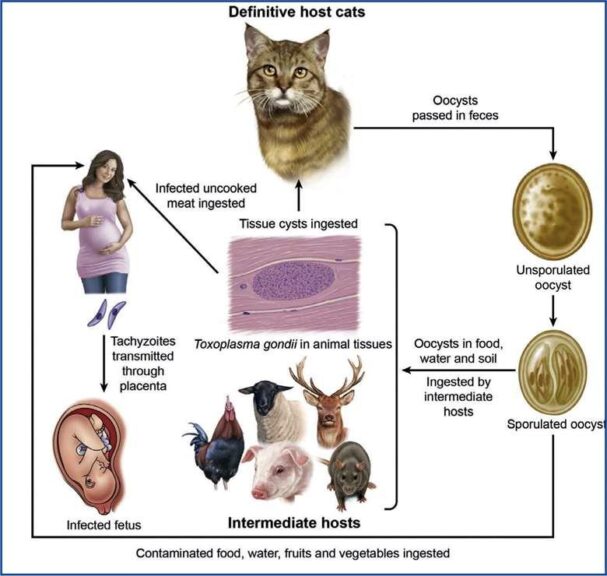
Interesting Fact
Can you imagine that a “parasite” can hypnotize its “host” for its transmission and multiplication to such an extent that the host becomes careless enough to get hunted down by its predator???
- Parasite: Toxoplasma gondii
- Intermediate Host whose behavior is altered: Rodents
- Predator: Definitive Host – Cats
Changes in rodents upon ingesting T.gondii:
- Rodents become careless, more extroverted and their inhibitions around cats are lost.
- Rodents stop turning on their defense mechanisms upon encounters with cats.
- Rodents start getting attracted by feline’s urine and its smell.
Yes, there are some “BEHAVIOUR-ALTERING PARASITES” that can manipulate and modify the behavior of their (intermediate) hosts to such an extent that tendencies of intermediate hosts are modified. Thereafter, the chances of the intermediate hosts being eaten by the definitive host (predator) increase in such cases. And who’s the culprit? The parasite!
In many of the parasites which are “trophically-transmitted”, meaning transmitted via food/ingestion, parasites possess special behavior-altering mechanisms to amp up their chances to reach their definitive hosts. This happens by manipulating and modifying the general decision-making abilities, controlling abilities, neurochemical signaling, and communication, behavioral mechanisms, hijacking of the host’s CNS (central nervous system), etc. For the sexual maturity of any parasite, reaching its final definitive host is very important. Thus, the intermediate host is hypnotized and made to follow all the directions that increase the chances of the parasite’s transmission to the definitive host, along with the surety of its safety and security all throughout the journey!
And, this mechanism is sometimes referred to as “Increased trophic facilitation or Parasite increased trophic transmission”.
(Source: Berdoy, M. et al, 2000, Boillat M., 2020)
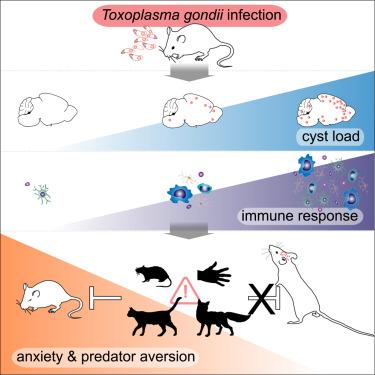
Try to answer the quiz below to check what you have learned so far about definitive hosts.
References
- Vlachou, D., Schlegelmilch, T., Runn, E., Mendes, A., & Kafatos, F. C. (2006). The developmental migration of Plasmodium in mosquitoes. Current opinion in genetics & development, 16(4), 384-391.
- Orihel, T. C. (1961). Morphology of the larval stages of Dirofilaria immitis in the dog. The Journal of parasitology, 47(2), 251-262.
- Jordan, P. (1952). Wuchereria bancrofti. Transactions of the Royal Society of Tropical Medicine and Hygiene, 46(2), 207-208.
- Edeson, J. F. B., & Wilson, T. (1964). The epidemiology of filariasis due to Wuchereria bancrofti and Brugia malayi. Annual Review of Entomology, 9(1), 245-268.
- Hong, S. T. (2003). Clonorchis sinensis. In International handbook of foodborne pathogens (pp. 601-612). CRC Press.
- Berdoy, M., Webster, J. P., & Macdonald, D. W. (2000). Fatal attraction in rats infected with Toxoplasma gondii. Proceedings. Biological Sciences, 267(1452), 1591–1594. https://doi.org/10.1098/rspb.2000.1182
- Lindová, Jitka; Příplatová, Lenka; Flegr, Jaroslav (2012). “Higher Extraversion and Lower Conscientiousness in Humans Infected with Toxoplasma“. European Journal of Personality. 26 (3): 285–291. doi:10.1002/per.838
- Duvaux-Miret, O., Stefano, G. B., Smith, E. M., Dissous, C., & Capron, A. (1992). Immunosuppression in the definitive and intermediate hosts of the human parasite Schistosoma mansoni by release of immunoactive neuropeptides. Proceedings of the National Academy of Sciences, 89(2), 778-781.
- World Health Organization: WHO. (2021, October 28). Malaria. World Health Organization: WHO. https://www.who.int/news-room/fact-sheets/detail/malaria
- Tyler, K. M., & Engman, D. M. (2001). The life cycle of Trypanosoma cruzi revisited. International journal for parasitology, 31(5-6), 472-481.
- Boillat, M., Hammoudi, P. M., Dogga, S. K., Pagès, S., Goubran, M., Rodriguez, I., & Soldati-Favre, D. (2020). Neuroinflammation-Associated Aspecific Manipulation of Mouse Predator Fear by Toxoplasma gondii. Cell reports, 30(2), 320–334.e6. https://doi.org/10.1016/j.celrep.2019.12.019
©BiologyOnline.com. Content provided and moderated by Biology Online Editors.

